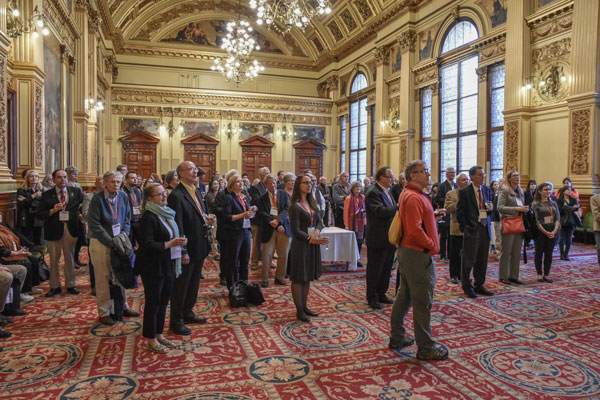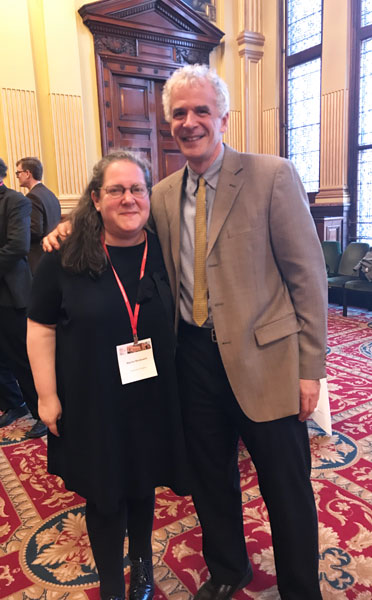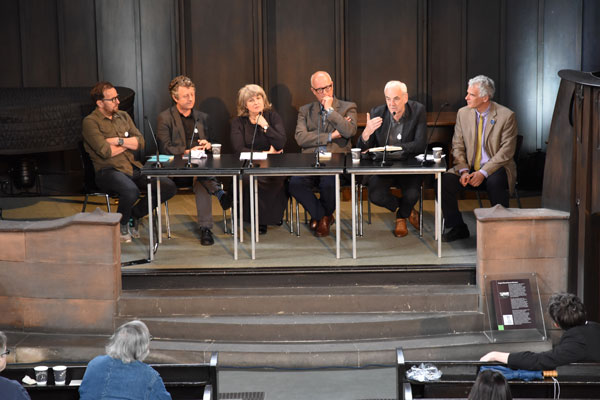-
Membership
Membership
Anyone with an interest in the history of the built environment is welcome to join the Society of Architectural Historians -
Conferences
Conferences
SAH Annual International Conferences bring members together for scholarly exchange and networking -
Publications
Publications
Through print and digital publications, SAH documents the history of the built environment and disseminates scholarship -
Programs
Programs
SAH promotes meaningful engagement with the history of the built environment through its programsMember Programs
-
Jobs & Opportunities
Jobs & Opportunities
SAH provides resources, fellowships, and grants to help further your career and professional life -
Support
Support
We invite you to support the educational mission of SAH by making a gift, becoming a member, or volunteering -
About
About
SAH promotes the study, interpretation, and conservation of the built environment worldwide for the benefit of all
Recap of the SAH 70th Annual International Conference in Glasgow, Scotland
Jul 20, 2017
by
Pauline Saliga, SAH Executive Director
When the Society of Architectural Historians made the decision to hold its annual conference in Glasgow, Scotland, we knew it was a captivating place from the standpoint of its architecture, parks, and cultural institutions, but we had no idea how warmly we would be welcomed by the “People Who Make Glasgow.” Throughout the conference week we were blessed with good company, many sunny days, a little light rain, and bountiful parks and gardens. More than 550 attendees from around the world came to Glasgow, June 7–11, 2017, for the SAH 70th Annual International Conference. The conference marked the first time SAH had met outside North America in over 40 years and coincided with Scotland’s Year of History, Heritage and Archaeology. A brief recap of the Glasgow conference’s events follows.
FINAL CONFERENCE STATS
Total Number of Attendees: 560
Countries Represented: 39
U.S. States Represented: 39
Number of Speakers: 185
Papers Delivered: 171
Number of Sessions: 36
Number of Roundtables: 9
Number of Tours: 26
Number of Exhibitors: 14 companies; 17 personnel
CONFERENCE PHOTO GALLERY
View conference photos on Flickr.

Glasgow School of Art Director Tom Inns welcomes attendees to the Mackintosh Symposium. (credit: Helena Dean)
Wednesday, June 7
SAH partnered with the Glasgow School of Art (GSA) to present a pre-conference symposium on Charles Rennie Mackintosh on the 149th anniversary of the birth of Scotland’ most renowned architect and designer. Chaired by Robyne Calvert, Mackintosh Research Fellow at the GSA, “Mackintosh: Materials and Materiality” looked at several major projects underway to restore and/or reconstruct Mackintosh’s architectural and design work. Speakers represented four major Mackintosh projects: The Glasgow School of Art, The Willow Tea Rooms, the interiors from the Ingram Street Tea Rooms in the collection of Glasgow Museums, and the National Trust for Scotland – The Hill House. Professor Emerita and Honorary Professional Research Fellow Pamela Robertson, University of Glasgow, delivered the keynote “The Stones of Glasgow,” which provided an overview of recent research, new insights, and current opportunities and challenges for Mackintosh’s built heritage.

SAH President Ken Oshima, The Rt Hon Eva Bolander The Lord Provost of Glasgow, and Glasgow School of Art Director Tom Inns (credit: John Gronkowski)
The conference officially kicked off with a reception at the magnificent Glasgow City Chambers, hosted by The Rt Hon Eva Bolander The Lord Provost of Glasgow. As SAH members enjoyed drinks and hors d’oeuvres, the Lord Provost took to the stage to welcome the Society of Architectural Historians to Glasgow. SAH President Ken Tadashi Oshima followed, welcoming attendees to the conference. On behalf of SAH, he presented a donation of 1,000 pounds to Tom Inns, director of the Glasgow School of Art, for the restoration of the Mackintosh Building that was destroyed in the 2014 fire.

SAH members are welcomed to Glasgow by the Lord Provost during Opening Social Hour at Glasgow City Chambers. (credit: John Gronkowski)

Conference Local Chair Marina Moskowitz, University of Glasgow, and Conference Chair and SAH 1st Vice President Sandy Isenstadt, University of Delaware
The SAH Annual Business Meeting followed and was held in the Technology and Innovation Centre, the conference’s headquarters. Ken Oshima, University of Washington, gave the President’s Address. He thanked the conference’s partners and sponsors, including Lead Sponsor The Richard H. Driehaus Foundation, as well as those individuals and organizations that provided funding for the conference’s many fellowships. SAH programs and publications from the past year were highlighted and the recipients of SAH fellowships and grants were recognized. Oshima announced new initiatives such as the SAH Architects Council, SAH Strategic Plan, and the SAH 2016 Annual Report, which will be published this summer. Kim Coventry, executive director of The Richard H. Driehaus Foundation, was in attendance and said a few words about the important work that SAH does and how proud the Foundation is to be a sponsor. SAH Treasurer Michael Gibson, Greenberg, Whitcombe, Takeuchi, Gibson & Graver, LLP, provided members with a financial overview and reported that SAH is operating in the black. SAH Secretary Kathryn O’Rourke, Trinity University, conducted the election of officers and incoming board members. Officers to serve a one-year term until June 2018 included President, Ken Tadashi Oshima, University of Washington, First Vice President, Sandy Isenstadt, University of Delaware, Second Vice President, Victoria Young, University of St. Thomas, Secretary, Kathryn O’Rourke, Trinity University, and Treasurer, Michael J. Gibson, Greenberg, Whitcombe, Takeuchi, Gibson & Graver, LLP. Newly elected directors to serve a three-year term until April 2020 included Ramla Benaissa, Ramla Benaissa Architects, Kathleen James-Chakraborty, University College Dublin, Itohan Osayimwese, Brown University, Jennifer Tate, University of Texas at Austin, and Konrad Wos, Wos & Wos Development.
After the Business Meeting, Conference Chair Sandy Isenstadt took the stage to introduce Brian Park, founding director of Page\Park Architects. Page gave the Introductory Address, “The Architects Who Made Glasgow.”
The conference’s public architecture tours ran each day from Wednesday through Sunday. Wednesday tours set out in the afternoon to explore Glasgow’s West End and Govan, stained glass at the Burrell Collection (closed to the public for renovation but opened for the SAH conference), the University of Glasgow campus, and the works of Gillespie, Kidd & Coia.
Thursday, June 8
Over 180 speakers delivered papers in 36 sessions on Thursday and Friday, organized into three tracks per day. Sessions covering Scottish topics included “Landscape and Garden Exchanges between Scotland and America” and “‘A Narrow Place’: Architecture and the Scottish Diaspora.” A record number of nine roundtables were offered this year. Society of Architectural Historians Great Britain (SAHGB), European Architectural History Network (EAHN), and Global Architectural History Teaching Collaborative (GAHTC) led roundtables in addition to those organized by SAH.

EAHN Roundtable, "Architectural History and Open Access in Europe" (credit: Helena Dean)

SAH Roundtable, "The State of the Mack" (credit: Helena Dean)

H. Allen Brooks Travelling Fellows 'Deyemi Akande (2016) and Danielle S. Willkens (2015) (credit: Helena Dean)
In the evening, SAH members headed to the University of Strathclyde’s historic Barony Hall for a reception, the awards ceremony, and plenary talk. SAH Second Vice President Victoria Young emceed the SAH Awards Ceremony. SAH inducted five new Fellows: filmmaker Michael Blackwood, Blackwood Producations; Rosemarie Haag Bletter, Professor Emerita, City University of New York Graduate Center; Christopher Curtis Mead, Emeritus Regents’ Professor of Architecture and Professor of Art History at the University of New Mexico; Joan Ockman, Distinguished Senior Lecturer at the University of Pennsylvania School of Design and Visiting Professor at Cooper Union’s Irwin S. Chanin School of Architecture; and Joseph Rykwert, Paul Philippe Cret Professor of Architecture Emeritus at the University of Pennsylvania. The recipients of the 2017 SAH Publication Awards and SAH Award for Film and Video were announced at the ceremony. Read more about the award winners here. Immediately following the awards ceremony, Kathleen James-Chakraborty, University College Dublin, delivered the plenary talk, “Architecture, its Histories, and their Audiences.”

SAH President Ken Oshima, Marta Gutman, SAH Executive Director Pauline Saliga, Elizabeth McKellar, Benjamin Ibarra Sevilla, and Conference Chair Sandy Isenstadt (credit: John Gronkowski)

Kathleen James-Chakraborty delivers the plenary talk at Barony Hall. (credit: Helena Dean)
Tours on Thursday continued with visits to The Merchants House of Glasgow, designed by John Burnet; George Square—the civic heart of Glasgow—and its monuments; and the Glasgow Necropolis, a Victorian garden cemetery inspired by Paris’ Père Lachaise with architecture by David Hamilton, Alexander ‘Greek’ Thomson, and Charles Rennie Mackintosh.
Friday, June 9
Paper sessions, roundtables, and meeting continued throughout the day on Friday. The GAHTC hosted a roundtable that covered the launch of its Mellon Foundation-funded shared platform for teaching materials and outlined its new initiatives. The annual Graduate Student Roundtable focused on the intersection of design practice and the study of architectural history, reframing disciplinary boundaries to open graduate students to the possibilities of new approaches to their research and professional development. With the conference in the great Victorian city of Glasgow, with its vast array of late 19th-century buildings and landscapes, there was perhaps no better time to offer the roundtable “Studying “Victorian Architecture: Where Next?,” which looked at the current state of Victorian architecture as a field of scholarly inquiry. “Confronting Challenges in the New Political Landscape,” had panelists discussing timely issues that directly impact the academic and cultural communities, such as funding cuts, limits to academic freedom, and the loss of important monuments to war, neglect, and climate change. Talking to My Father, by Sé Merry Doyle, the 2017 winner of the SAH Award for Film and Video, was shown during the midday break. No events were scheduled for Friday evening, allowing attendees the chance to explore Glasgow’s restaurants and nightlife after sessions ended for the day.

Conference attendees meeting inside the Technology and Innovation Centre between sessions. (credit: Helena Dean)
On Friday afternoon participants delved into Glasgow’s colonial history with tours of the Cuninghame Mansion, built for the Virginia ‘Tobacco Lord’ William Cuninghame of Lainshaw, and Trongate, one of the city’s oldest streets. Others took part in a tour of Glasgow City Chambers, the headquarters of Glasgow City Council, and a second tour of the Glasgow Necropolis was offered that included a visit to the adjacent Glasgow Cathedral, Scotland’s best preserved and largest surviving Gothic church.
Saturday, June 8
Conference attendees and members of the public gathered at Mackintosh’s Queens Cross Church on Saturday morning for the SAH Glasgow Seminar “Making and Re-Making Glasgow: Heritage and Sustainability.” Local speakers representing the academic, museum, ecological, and cultural sectors each gave talks that explored heritage and sustainability through the lens of their respective fields and considered how these two drivers of the urban form can work together to support community, the environment, and good design. A screening of Chris Leslie’s short film (Re)Imagining Glasgow followed the talks. The program closed with a panel discussion that addressed the themes covered in the talks.

Chris Leslie introduces his film (Re)Imagining Glasgow before its screening at the SAH Glasgow Seminar. (credit: Helena Dean)

A reception was held midway through the SAH Glasgow Seminar at Mackintosh Queen's Cross Church. (credit: Helena Dean)

SAH Glasgow Seminar panelists Chris Leslie, Chris Stewart, Anne McChlery, Alistair MacDonald, Ranald McInnes, and Sandy Isenstadt. (credit: John Gronkowski)
Tours continued throughout the day on Saturday. Participants saw castles in Stirlingshire and lowland Scotland, explored the buildings by Allan Dreghorn and Alexander Thomson, and toured the towns of Cumbernauld, Cove and Kilcreggan, and Pollokshields.
On Saturday night, SAH hosted "The Architects' Birthday Party" inside Kibble Palace at the Glasgow Botanic Gardens to celebrate the close of the conference. Guests enjoyed drinks and hors d'oeuvres as they mingled among the lush gardens of tropical plants and statues of the Victorian glasshouse.

Kibble Palace, Glasgow Botanic Gardens (credit: Helena Dean)

Conference Chair and SAH 1st Vice President Sandy Isenstadt and Kathleen James-Chakraborty (credit: Helena Dean)
Sunday, June 9
Sunday featured day-long tours that gave participants a chance to experience architecture and landscapes outside the city of Glasgow. Attendees traveled north to Highland Perthshire to explore Scotland’s historic urban and rural vernacular buildings, and south to South Lanarkshire to see the UNESCO World Heritage site of New Lanark, the hunting lodge at Chatelherault, and Bothwell Castle. A tour of Mackintosh’s work in the suburbs of Helensburgh and Kilmacolm included visits to The Hill House and Windyhill. And two tours of Edinburgh were offered—one that explored the city’s historic Old Town and another that focused on its planned New Town and the work of William Playfair, Edinburgh’s leading 19th-century architect.
On behalf of the SAH Board and membership, I extend our gratitude to all who worked to make the Glasgow conference a success, including speakers, session chairs, roundtable panelists, tour leaders, volunteers, conference partnerships, and conference sponsors. Special thanks to the Conference Chair Sandy Isenstadt, SAH First Vice President, University of Delaware, and Local Chair Marina Moskowitz, University of Glasgow. I’d like to thank the SAH staff for their hard work managing the conference: Director of Program Christopher Kirbabas, who oversaw every aspect of the conference, Program Coordinator Chris Higgins, who managed fellowships and registration, Director of Communications Helena Dean, who handled partnerships and conference marketing and design, Director of Development Carolyn Garrett, who raised sponsorship and conference underwriting, Director of Membership Anne Bird, who managed conference volunteers, and Comptroller Beth Eifrig, who managed all fiscal matters related to the conference.
We also extend our sincere appreciation to those individuals, companies, and organizations that provided support for the conference. Thank you all for making the SAH 70th Annual International Conference a success. We hope you’ll join us for our 71st annual conference in Saint Paul, Minnesota, April 18–22, 2018.
Pauline Saliga
SAH Executive Director


